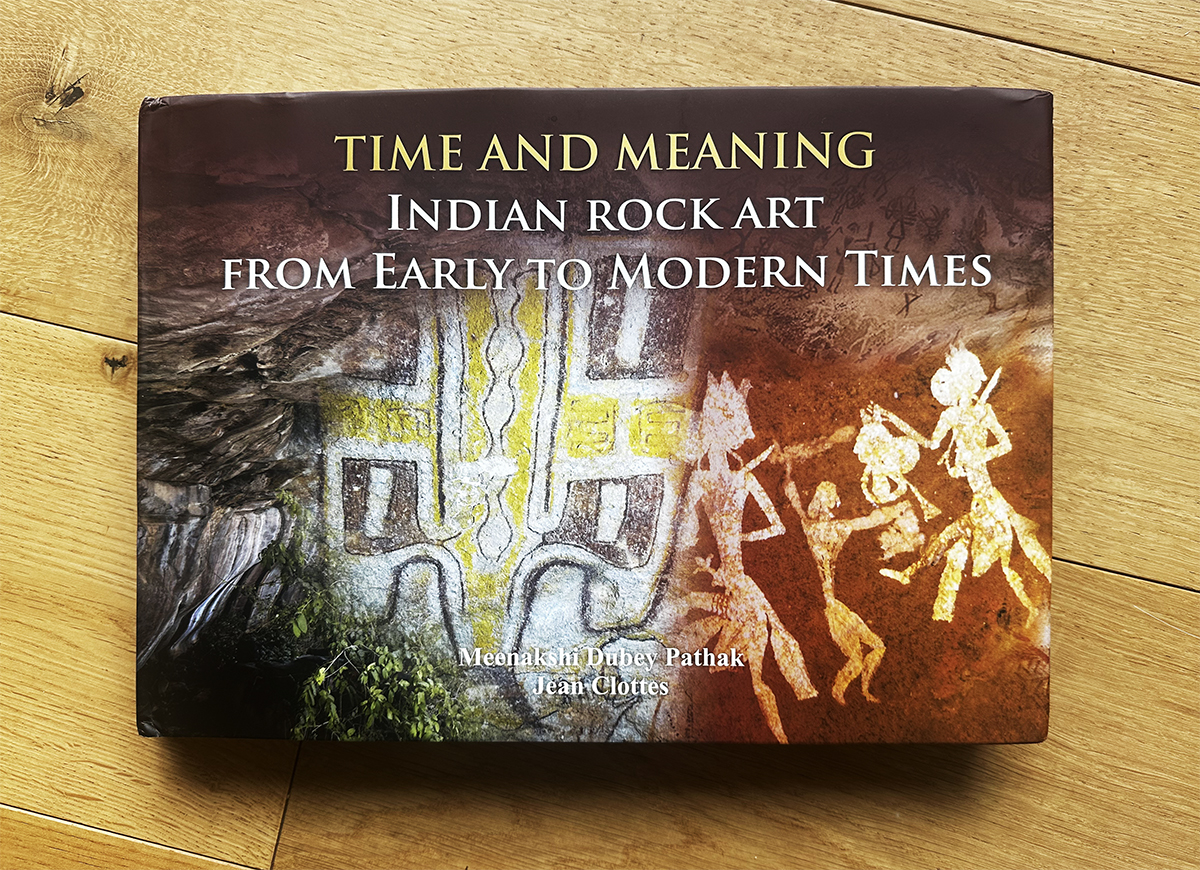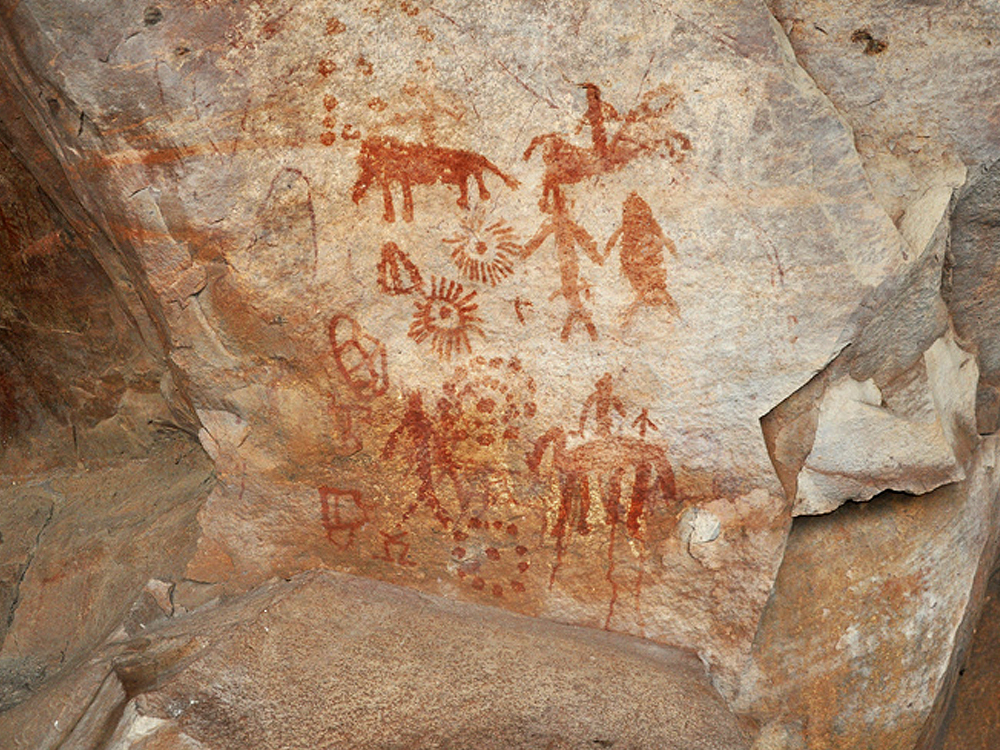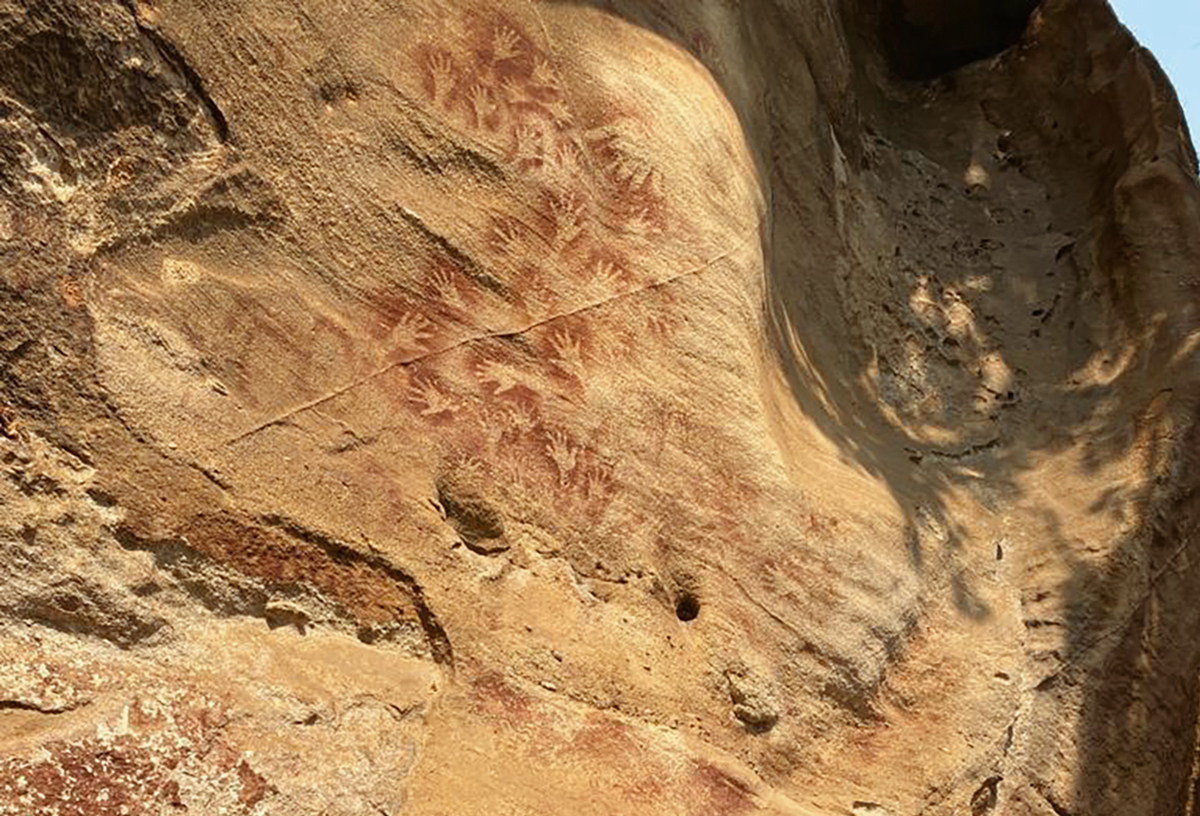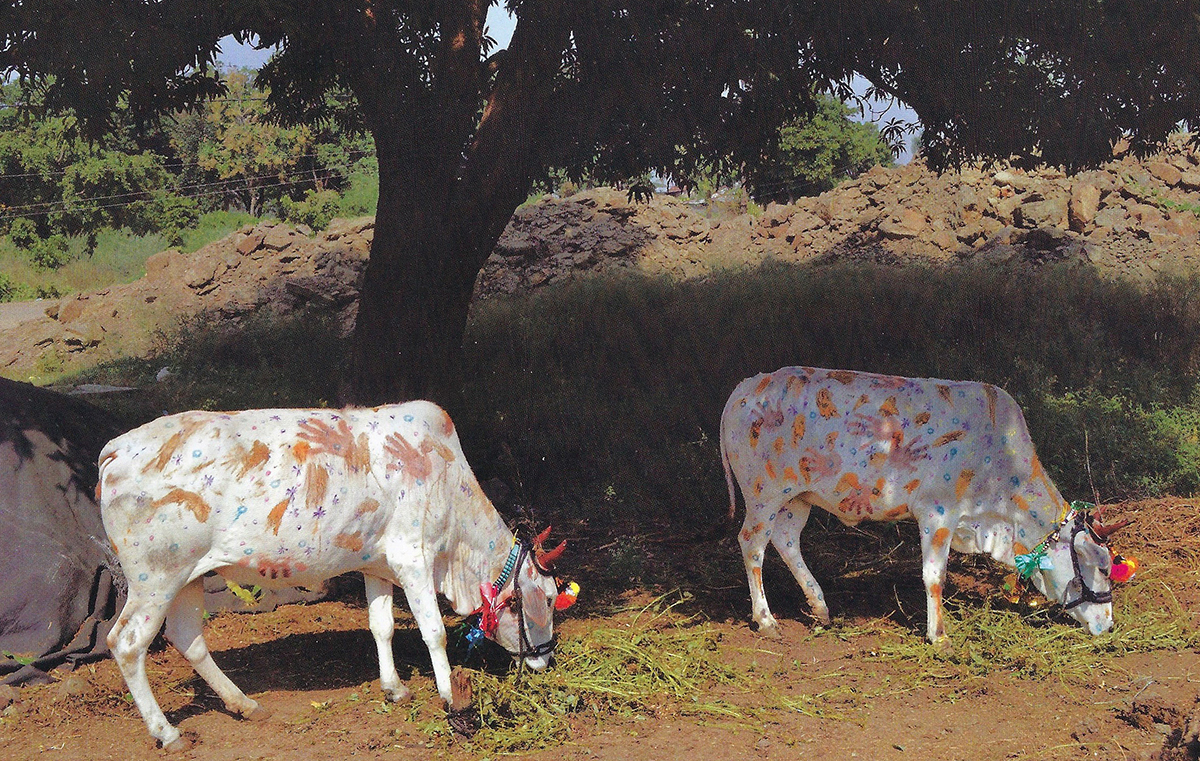


'Time and Meaning - Indian Rock Art From Early to Modern Times'
By Meenakshi Dubey-Pathak and Jean Clottes
New Publication

Bradshaw Foundation review:
'Time and Meaning - Indian Rock Art From Early to Modern Times' represents yet another excellent collaboration between Dr Meenakshi Dubey-Pathak and Dr Jean Clottes. And the clues are in the title; the authors discuss Indian rock art that has taken place over time, they look at the possible meanings of the motifs and symbols and they present a publication that has a multi-regional approach. With the chronological context, the a posteriori observation is that India is one of the few remaining places on the planet where rock art researchers can track an artistic phenomenon from the ancient to the modern. It is a cultural journey that weaves through time - over 12,000 years - in different ways and with different outcomes.

The publication sets out with its regions of study: the rock art of Ladakh in northern India, Madhya Pradesh, Rajasthan and Chhattisgarh. Research so far has revealed that the oldest rock art of India belongs to the Mesolithic, dating back to some 12,000 years ago. So far, no rock art ('except cupules, if they can be considered as art') has been securely dated to the Palaeolithic, although that may well change with further investigation. Then, from the Mesolithic - roughly 10,000 BC to 2,500 BC - to the Neolithic - roughly 2,500 BC to 300 AD - to the Historic - roughly 300 AD to 800 AD - to the Medieval Historic - roughly 800 to 1300. Throughout, the art has evolved whilst retaining a homogeneous nature.

But the story goes further; there is a clear 'persistence of tradition'. In India, traditional forms of tribal art still persist in many places, even if partly mixed with Hinduism. When the authors visited rock art sites, they very often observed fresh deposits - broken pieces of coconut husks, burnt incense sticks - which always led them to consult with the people from the nearest village. In many cases, the rock art sites are far from dead, but instead host tribal groups and their ritual practices.

In India, where there is strong reverence to gods and local gods, the custom of making an offering - for benefits, for protection - is ubiquitous. The authors' research shows that in very many cases, these offerings are made in a painted or engraved shelter, in other words, in a place already considered to be full of active power.
The publication analyses the 'transformation' of rock art sites. Initially, once a site is painted, it comes 'alive' - it becomes sacred and powerful. What happens next can vary; new traditional paintings may be added, or other religious paintings may be added (sometimes covering the original paintings), or a temple may be built, or a combination of all of these. The site is still sacred and powerful, it has just evolved. The publication also considers how the ancient artistic tradition is still manifested in other ritual practices, from the rock art sites to the home.
For the authors, this new publication is a call to arms; further research in India must be carried out, with precise mapping of rock art site locations and the application of the advancing dating techniques. Obviously there must be further research involving a study of the archaeological context but equally importantly a greater documentation of the ethnological traditions. The latter represents not just a cultural 'residue' of the ancient rock art but a clear and present thread as complex, varied and vital as any mitochondrial network. This call to arms comes with a warning: do it now because this source of understanding will not last forever.
Product details: Title: 'Time and Meaning - Indian Rock Art From Early to Modern Times' Authors: Meenakshi Dubey-Pathak and Jean Clottes Item code: UBE814 Publisher: Pathak Publisher & Distributors Language: English Edition: 2023 ISBN: 9789391952150 Pages: 310 Cover: Hardcover
About the Book:
While people were making rock art, they no doubt practiced many other forms of art, on their bodies, on their clothes, on their habitations, on their tools and weapons and on all sorts of perishable materials. With the passing of time, all this is gone. Nowadays, though, traditional forms of tribal art still persist in many places, even if partly mixed with Hinduism, for example when some rituals take place for Diwali. We have seen and studied some of them, like painting cows and houses or making cow-dung sculptures called gobardhans. In most parts of the world, such practices are long gone and so are the meanings that went with them. This is why it is so important to record them while we can. Rock art, for physical reasons, is the best preserved of tribal arts. It is present in thousands of sites all over India, with more concentrations in the center of the country. In our book, we shall see that rock art has never been still and unmovable: it has considerably evolved over the past 12,000 years.
About the Authors:
Dr Meenakshi Dubey-Pathak has specialized in the field of Indian Rock Art, which started in the Mesolithic (more than 10,000 years ago) or even before During her many years of fieldwork she discovered dozens of new painted sites, mostly in Madhya Pradesh (particularly in the Pachmarhi area about which she did her PhD), but also in Chhattisgarh, Rajasthan and Ladakh.
She has devoted nearly thirty years of her life to the discovery, study, publication, exhibitions, workshops and protection of Indian Rock Art. This has already eamed her a deserved international recognition. She has published many papers and four books: "Rock Art of Pachmarhi Biosphere", Delhi, BR Publications, 2012. "Des Images pour les Dieux. Art rupestre et Art tribal dans le Centre de l'Inde (with Jean Clottes). Arles (France), Éditions Errance, 2013. "Powerful Images. Rock Art and Tribal Art of Chhattisgarh" (with Jean Clottes). Bloomsbury Publications, 2017. "Madhya Pradesh Rock Art and Tribal Art" (with Jean Clottes), INTACH and Aryan Books International. She was Internationally awarded the high honour of Chevalier des Arts Lettres'-Knight in the National Order of Arts and Letters- by the French Minister of Culture and Communication in 2014.
She is an International Expert for rock art with ICOMOS and UNESCO. She was awarded Heritage Fellowship with Ministry of Culture, France. Also She is a Wakankar Senior Research Fellow.
Film on the "Central Indian Rock Art and Tribal Art", based on her research work, screened and awarded in the International Archaeology Film Festival in Nyon, Switzerland. March 2019.
She is a member of the Bradshaw Foundation Advisory Board (England) and a member of the Rock Art Network of the Getty Foundation (US).
Dr Jean Clottes studied at Toulouse University He was a Director of Prehistoric Antiquities for Midi Pyrénées from 1971 onwards, and after being a General Inspector for Archaeology at the Ministry of Culture (1991) he became a Scientific Advisor at the same Ministry for everything relating to prehistoric rock art, a position he held until his official retirement in July 1999.
He created and directed the International Newsletter on Rock Art (INORA). He has taught courses at the Universities of Toulouse (France). Neuchâtel (Switzerland), Gerona (Spain), Buenos Aires (Argentina, INAPL), Berkeley (USA), Victoria (Canada).
He is also an International Expert for rock art with ICOMOS and UNESCO.
He has published or co-published 30 books, directed 13 others and more than 600 papers. Seven of his books (and many papers) have been published in English: The Cave Beneath the Sea (Harry Abrams, 1996); The Shamans of Prehistory, with D. Lewis-Williams (Harry Abrams, 1998); World Rock Art (Getty Foundation, 2002); Chauvet Cave: the art of earliest times (ed.) (The University of Utah Press, 2003); Cave Art (Phaidon, 2008); with Meenakshi Dubey-Pathak). "Powerful Images. Rock Art and Tribal Art of Chhattisgarh Bloomsbury Publications, 2017. "Madhya Pradesh Rock Art and Tribal Art" (INTACH and Aryan Books International).
Click here to visit the Rock Art of India Archive
Commentby Bradshaw Foundation
Wednesday 22 May 2024
by Bradshaw Foundation
Friday 10 November 2023
by Bradshaw Foundation
Thursday 12 January 2023
by Bradshaw Foundation
Thursday 10 November 2022
by Bradshaw Foundation
Tuesday 06 September 2022
by Bradshaw Foundation
Wednesday 20 July 2022
by Bradshaw Foundation
Monday 20 June 2022
by Bradshaw Foundation
Thursday 03 September 2020
by Bradshaw Foundation
Wednesday 26 August 2020
by Bradshaw Foundation
Saturday 27 June 2020
by Bradshaw Foundation
Tuesday 28 April 2020
by Bradshaw Foundation
Wednesday 22 May 2024
by Bradshaw Foundation
Friday 10 November 2023
by Bradshaw Foundation
Thursday 12 January 2023
by Bradshaw Foundation
Thursday 10 November 2022
by Bradshaw Foundation
Tuesday 06 September 2022
by Bradshaw Foundation
Wednesday 20 July 2022
by Bradshaw Foundation
Monday 20 June 2022
by Bradshaw Foundation
Thursday 03 September 2020
by Bradshaw Foundation
Wednesday 26 August 2020
by Bradshaw Foundation
Saturday 27 June 2020
by Bradshaw Foundation
Tuesday 28 April 2020
Friend of the Foundation











